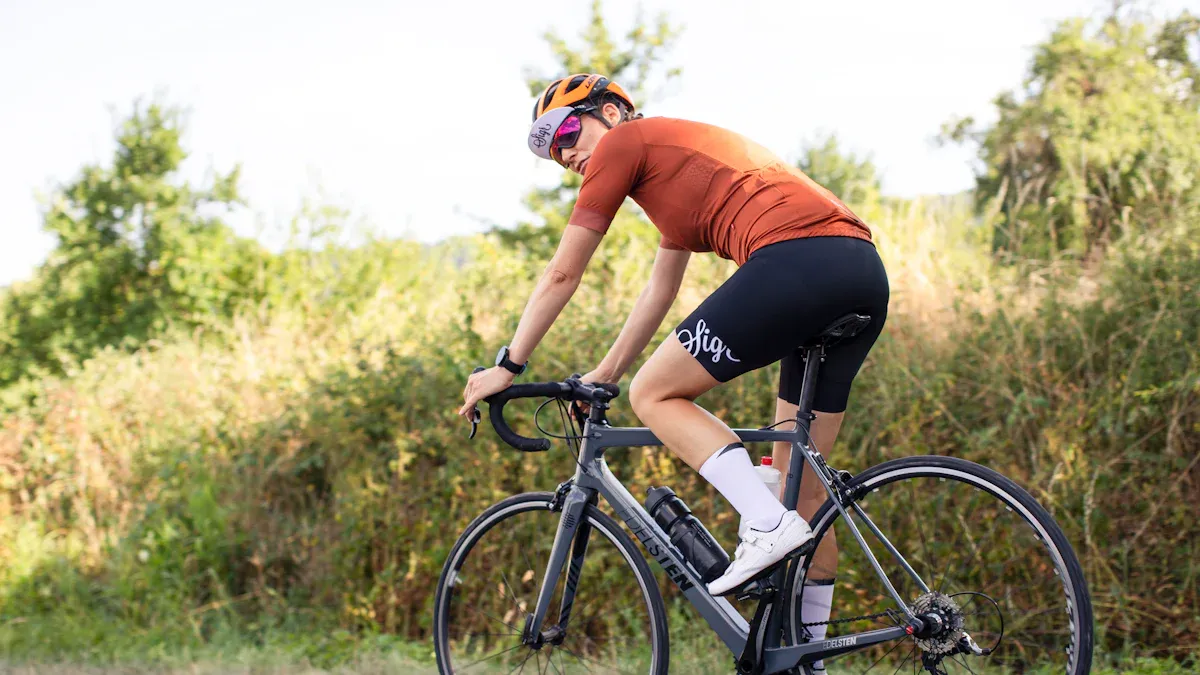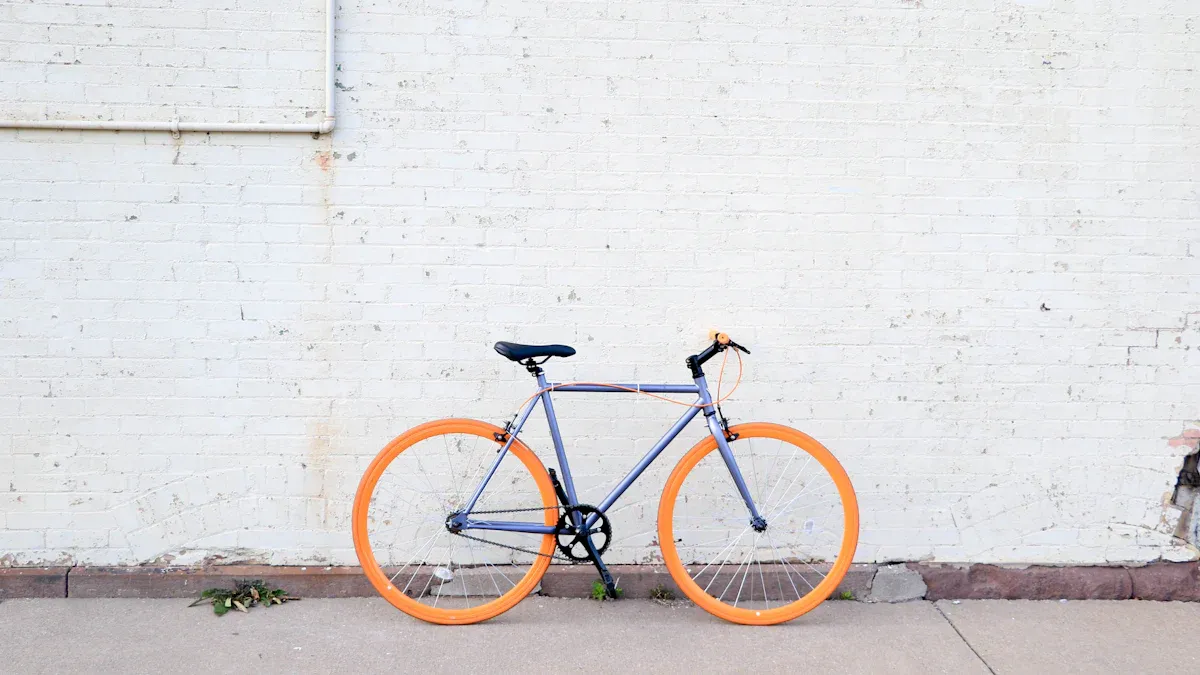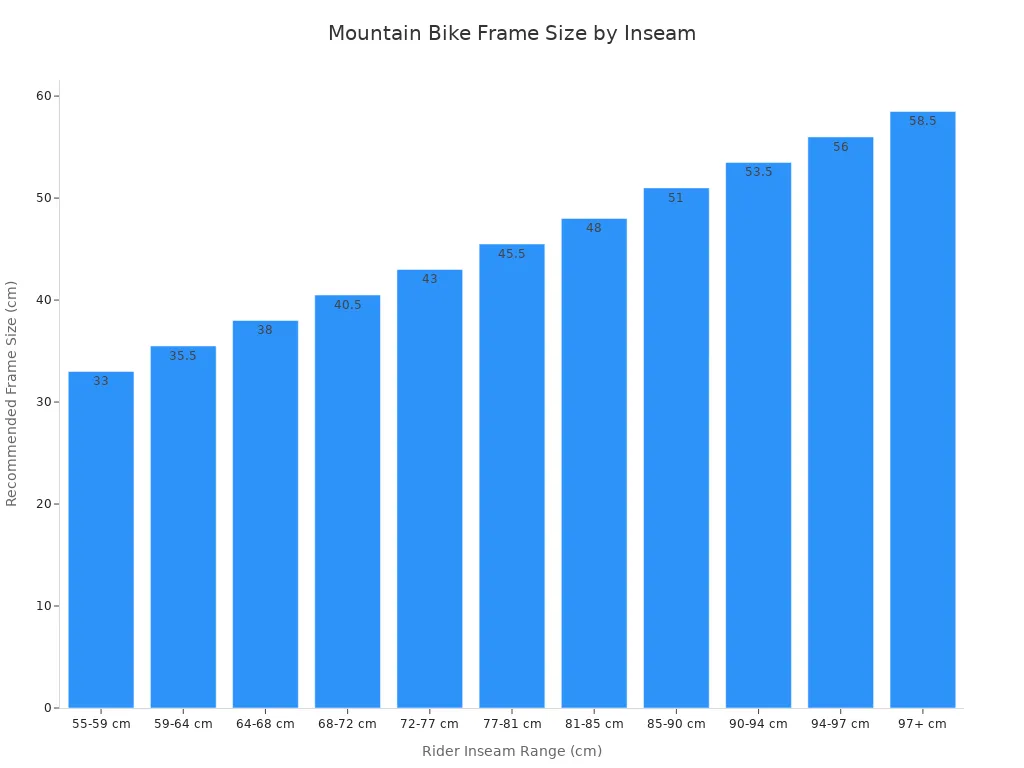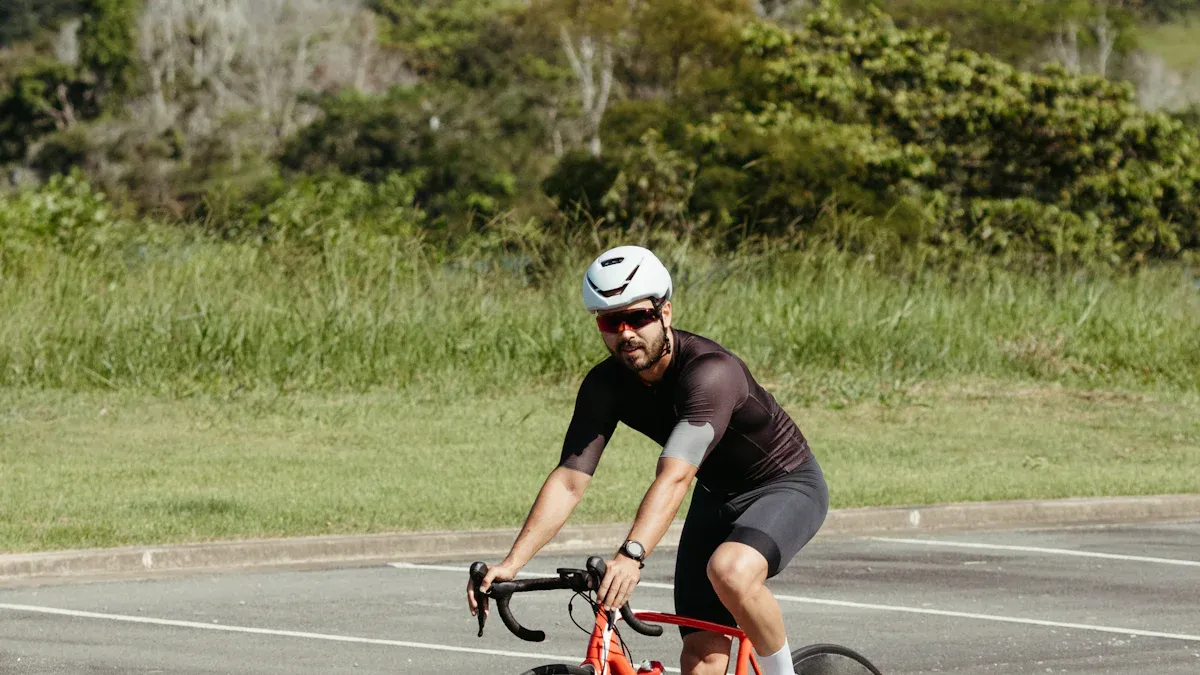
Choosing the right bike size is very important. It helps you feel comfortable and perform well on the road or trail. If your bike is the wrong size, it can cause discomfort and make it hard to handle. It can also create safety problems. To find the best fit, focus on key measurements. These include your height and inseam length. These measurements will help you pick the right adult bike frame size. This way, you can reach the pedals and handlebars easily.
Key Takeaways
Measure your height and inseam carefully to find the right bike frame size using size charts.
Choose a bike size that fits your body to stay comfortable, ride better, and avoid safety risks.
Check your bike fit by testing reach, seat height, and handlebar position for a smooth ride.
Adjust your bike parts or get a professional fitting to improve comfort and control.
Try different bike sizes in a local shop to find the best fit for your riding style and needs.
Why Bike Size Matters
Choosing the right bike size is very important. It affects how comfortable you feel and how well you ride. When your bike fits you, you can sit naturally. This helps you pedal better and feel less tired on long rides. A study found that wrong crank lengths can make you feel more tired. This happens even if they don’t change your speed or power. So, a bike that feels bad can make your rides seem longer and harder.
Safety is also very important when picking a bike size. If your bike is too small, it can cause steering problems. You might hit your toes on the front wheel or bump your legs on the handlebars. These issues can be dangerous in tight spaces or busy areas. If your bike is too big, it can make it hard to balance. You might not be able to touch the ground when you stop or have trouble turning sharply.
Here are some safety risks of having the wrong bike size:
A small frame can hurt and cause knee pain, making it hard to control.
A large frame can make balancing tough, raising the chance of falling.
Using a bike that doesn’t fit can cause problems, like bent seatposts or broken frames.
Toe overlap can happen when turning sharply, which can be risky.
Key Measurements for Adult Bike Sizing

To find the right bike size, you need three important measurements: inseam, height, and reach. Each measurement helps make sure your bike fits well and improves your ride.
Inseam Measurement
Inseam measurement is important for knowing how high your bike should be. This measurement makes sure you have enough space between your inseam and the top tube of the bike. Here’s how to measure your inseam correctly:
Put a book or something similar between your legs like a bike saddle.
Have someone measure from the top of the book to the floor; this is your inseam length.
Use this inseam length with a bike size chart to find the right bike frame size.
Make sure there is about one or two inches of space between your inseam and the bike’s top tube for comfort and safety.
For road bikes, multiply your inseam length by 0.67 to find the best frame size in centimeters. For mountain bikes, ensure you have 1-2 inches of space for standover height. This measurement affects frame size, seat tube length, and overall fit.
Height Measurement
Your height is another key factor in choosing the right bike frame size. To measure your height correctly, follow these steps:
Mark the top of your head on the wall.
Measure from the floor to the mark to get your height.
Use this height measurement with a bike size chart to find the right bike frame size.
Think about the type of bike (like road or mountain) since sizing can differ.
Height measurements help sort bike sizes into standard groups, like XS, S, M, L, XL, and XXL. For example, if you are between 4’10” and 5’2″, you would usually fit an XS frame. If you are over 6’4″, you would likely need an XXL frame. Remember, while height is important, using it with your inseam measurement gives a better fit.
Reach Measurement
Reach measurement is the distance from the saddle to the handlebars. This measurement is important because it affects how far you must reach to grab the handlebars, which impacts your comfort and control while riding. Here’s why reach is important:
A longer reach gives a roomier feel and better stability at high speeds. It can also boost confidence on tricky terrain.
A shorter reach makes the bike feel more responsive, which helps when moving in tight spaces.
To measure reach, look at the distance from the tip of the saddle to the center of the handlebars. Adjusting the reach helps improve your upper body position, which is key for comfortable and efficient riding.
Knowing these three measurements—inseam, height, and reach—will help you choose the right bike size. Proper sizing not only improves your riding experience but also keeps you safe on the road or trail.
Adult Bike Frame Size Charts
Choosing the right bike size is crucial for your comfort and performance. Below are the size charts for different types of adult bikes, including road, mountain, and hybrid bikes. These charts will help you find the perfect fit based on your height and inseam measurements.
Road Bike Size Chart
Road bikes typically use frame sizes measured in centimeters. Here’s a chart that shows how your height and inseam measurements correspond to frame sizes:
Rider Height Range (cm) | Leg Inseam Range (cm) | Frame Size (cm) | Standard Size Label |
|---|---|---|---|
64 – 67 | 45 – 46 | XXS | |
144 – 157 | 67 – 71 | 47 – 49 | XS |
153 – 166 | 71 – 74 | 50 – 52 | S |
162 – 174 | 74 – 78 | 53 – 54 | M |
170 – 183 | 78 – 82 | 55 – 57 | L |
178 – 188 | 82 – 85 | 58 – 59 | XL |
184 – 198 | 85 – 89 | 60 – 62 | XL |
193 – 205 | 89 – 93 | 63 – 64 | XXL |
199+ | 93+ | 65 – 67 | XXL |

Mountain Bike Size Chart
Mountain bikes often use a different sizing system, typically measured in inches. Here’s a chart that outlines the recommended frame sizes based on your height and inseam:
Rider Inseam (cm) | Rider Height (cm) | Frame Size (cm) | Size Category |
|---|---|---|---|
150 – 160 | 32 – 34 | XXS | |
59 – 64 | 150 – 165 | 35 – 36 | XS |
64 – 68 | 155 – 170 | 37 – 39 | S |
68 – 72 | 165 – 175 | 40 – 41 | S |
72 – 77 | 170 – 180 | 42 – 44 | M |
77 – 81 | 175 – 185 | 45 – 46 | M |
81 – 85 | 180 – 190 | 47 – 49 | L |
85 – 90 | 184 – 193 | 50 – 52 | L |
90 – 94 | 187 – 196 | 53 – 54 | XL |
94 – 97 | 190 – 200 | 55 – 57 | XL |
97+ | 195+ | 58 – 59 | XXL |

Hybrid Bike Size Chart
Hybrid bikes combine features from both road and mountain bikes. They typically use a sizing system similar to mountain bikes. Here’s a chart to help you find the right size:
Size | Rider Height Range | Inseam Range |
|---|---|---|
Approximately 5’1″ to 5’5″ | About 28″ to 31″ | |
Medium | Approximately 5’5″ to 5’9″ | About 30″ to 33″ |
Large | Approximately 5’9″ to 6’1″ | About 32″ to 35″ |
XL | Approximately 6’1″ to 6’6″ | About 34″ to 37″ |
XXL | Approximately 6’6″ to 6’8″ | About 36″ to 37.5″ |
To check if a hybrid bike frame fits, stand over the top tube with both feet flat on the ground. You should have about an inch of clearance between you and the top tube.
Understanding these adult bike frame sizes will help you select the right bike for your needs. Always refer to the bike size chart for accurate measurements.
How to Check if a Bike is the Right Size

To see if a bike fits you well, start with the bike size chart. Follow these steps to pick the right frame:
Measure your height by standing against a wall without shoes. Measure from the floor to the top of your head.
Measure your inseam by measuring from the floor to your crotch. This helps make sure your legs can extend properly.
Use a bike size chart that matches your height and inseam to the right frame size. Different bike types may have different sizing needs.
Think about your riding style and the type of bike you want. Mountain bikes and road bikes often fit differently.
Test ride the bike to see if it feels comfortable. Check your foot placement, leg bend while pedaling, and how easily you can reach the handlebars.
Change the seat height, handlebar position, and pedals as needed to get a better fit.
While frame size is important, other things also matter for a good bike fit. Here are some key points to think about:
Riding Style: Your riding style can change your fit. For example, aggressive riders may want a different fit than those who ride slowly.
Comfort and Flexibility: If you are not very flexible, you might need a smaller frame or adjustable parts to feel comfortable.
Terrain: The kind of terrain you ride on can also affect your fit. Tough trails may work better with smaller frames and bigger wheels for better control.
Professional Bike Fitting: Think about getting a professional bike fitting. This service can help you make personal adjustments, like seat height and handlebar angle.
Adjusting the bike can really improve your riding experience. For example, saddle height affects how well you pedal. A well-adjusted saddle lets you extend your legs almost fully without rocking your hips. Also, handlebar position changes your posture and balance. Handlebars that are too high can make you sit up straight, while those too low can cause discomfort. Aim for a handlebar height that is level with or just below your saddle height for the best performance.
Avoid common mistakes when checking bike fit. Many riders skip professional fittings, which can lead to bad adjustments. Ignoring proper riding posture can cause pain in your neck, back, and wrists. To keep a neutral spine, keep your back straight but relaxed. Use your core muscles to support your upper body and lessen strain on your hands. Make sure your bike fits well, either through a professional fitting or by using a good bike fit guide.
By following these steps and thinking about these points, you can find the right bike size for you. A good bike fit not only makes you more comfortable but also improves your overall riding experience.
Tips from the Bike Size Guide
Casual Riding
When you ride for fun, comfort is very important. Here are some tips to help you pick the right bike size:
Measure your height and inseam to find the right frame size.
Think about the type of bike you want. Road, mountain, and hybrid bikes have different sizes.
Use reach and stack measurements to adjust your size choice if you are between sizes.
Make sure there is space between the top tube and your crotch. Aim for about 2 cm for road bikes and 4 cm for mountain bikes for safety and comfort.
Go to a local bike shop to try different bikes and check the fit. This hands-on experience can help you find the best bike.
Changing the stem length can help with reach but may change how the bike handles.
Look for a slight bend in your knees at the bottom of the pedal stroke and a comfortable reach to the handlebars.
Commuting
For commuting, you need a bike that fits well and is easy to control. Here are some tips:
Pick a bike that lets you sit up straight. This helps you see traffic better and eases back strain.
Make sure your bike has a comfy saddle. A good saddle makes your daily rides more enjoyable.
Test ride different bikes to find one that feels right. Notice how your legs move while pedaling and how easily you can reach the handlebars.
Think about adding accessories like fenders and lights for safety during your commute.
Performance Riding
If you want to perform well, getting the right bike size is very important. Here are some things to think about:
A professional bike fitting is very helpful. Fitters measure inseam, adjust seat height, and fine-tune handlebars for the best performance.
If you are between sizes, choose a smaller frame for athletic riding. A larger frame is better for a relaxed, upright position.
Test rides are very important. Check comfort, seat height, leg extension, and handlebar reach during these rides.
Small adjustments can help fit, but a very wrong frame size cannot be fully fixed.
Don’t just rely on height; also consider inseam and arm reach for a better fit.
Performance Factor | Description & Impact on Performance |
|---|---|
Affects how much you bend over; a taller headtube raises handlebars closer, which changes comfort and stiffness. | |
Effective Top Tube Length | Affects reach and upper body position; too long makes you stretch, too short makes you feel cramped. |
Chainstay Length & Wheelbase | Longer chainstays and wheelbase make the bike more stable on rough ground; shorter lengths help with agility. |
By following these tips from the bike size guide, you can find a better fit for your riding style, whether you ride for fun, commute, or compete.
Picking the right bike size is very important for your comfort and how well you ride. Always check the size chart to find the best fit for you. Getting the right measurements helps you choose a bike that works for you.
Tip: Trying out different bike sizes can help you find what you like best. You can see how comfortable it feels, how you sit while riding, and how the bike handles. This will help you make smart choices based on your body and how you ride.
If you can, go to a local bike shop to try different sizes. Many stores let you return bikes if they don’t fit well. This way, you can ride with confidence, knowing you have the best bike for your adventures. 🚴♂️
FAQ
What is the best way to measure my inseam for bike sizing?
To measure your inseam, stand against a wall with your feet flat. Place a book between your legs, mimicking a bike saddle. Measure from the top of the book to the floor. This gives you an accurate inseam length for sizing.
How do I know if a bike fits me properly?
A proper bike fit allows you to reach the handlebars comfortably while keeping a slight bend in your knees when pedaling. You should also have a few inches of clearance between your inseam and the top tube when standing over the bike.
Can I adjust my bike if it doesn’t fit perfectly?
Yes! You can adjust the seat height, handlebar position, and stem length to improve your fit. These adjustments can enhance comfort and control, making your rides more enjoyable.
What if I am between two bike sizes?
If you find yourself between sizes, consider your riding style. A smaller frame offers more control for aggressive riding, while a larger frame provides comfort for casual rides. Test both sizes to see which feels better.
Why is bike fit important for safety?
A proper bike fit enhances your control and balance. If your bike is too small or too large, you may struggle with steering or stopping, increasing the risk of accidents. Always prioritize a good fit for safety.
